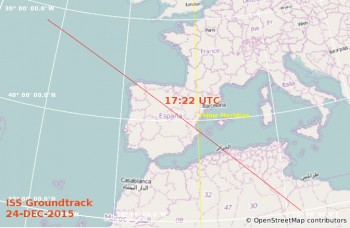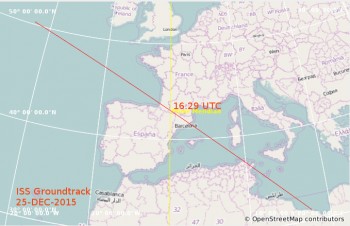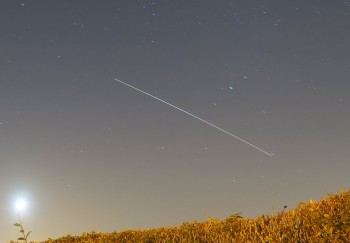With Tim Peake on the International Space Station and a rare full moon there are two very good reasons to go outside and look to the stars on Christmas Eve and Christmas day.
 These maps showing the Space Station’s path over Europe on 24 and 25 December. The closer you are located to the line on the map the closer the Space Station will fly overhead.If you are south of the line, look north and vice versa. For worldwide predictions we recommend the astroviewer website: https://iss.astroviewer.net/observation.php
These maps showing the Space Station’s path over Europe on 24 and 25 December. The closer you are located to the line on the map the closer the Space Station will fly overhead.If you are south of the line, look north and vice versa. For worldwide predictions we recommend the astroviewer website: https://iss.astroviewer.net/observation.php
The orbiting research centre will pass over Spain on the 24th so observers in England should see it low in the sky looking to the South West.
 On 25 December the Space Station passes over the Spanish-French border soon after sunset in England. It would have an elevation of about 30° in SW England and about 20° if viewed from the London area. As the sky will still be lit by the Sun from this direction the Space Station will not appear as bright on launch day, 15 December, for Tim Peake, Yuri Malenchenko and Tim Kopra. Experienced observers should have no problem spotting the Station even without binoculars.
On 25 December the Space Station passes over the Spanish-French border soon after sunset in England. It would have an elevation of about 30° in SW England and about 20° if viewed from the London area. As the sky will still be lit by the Sun from this direction the Space Station will not appear as bright on launch day, 15 December, for Tim Peake, Yuri Malenchenko and Tim Kopra. Experienced observers should have no problem spotting the Station even without binoculars.

Space Station seen on 15 December during docking. Credits: Bjarne Duelund, @BDuelund, https://twitter.com/BDuelund/status/676815934431039488
The Space Station looks like a very bright star or aircraft gliding through the sky. If you want to take a picture, use a tripod and set the shutter speed to a long exposure of up to a minute. The Station will always arrive from the west and will show up as a white streak in the photograph.
If you fail to spot the Space Station Christmas brings another treat for stargazers, a full Moon. Not since 1977 has a full Moon been seen on Christmas Day, and it will not happen again until 2034. This rare occurrence is also called a full cold Moon.
So put on a jacket, head outside, look up, wave and take a picture. We would love to see the results!



Discussion: 17 comments
Oh my goodness this is ‘Real Magic’ Happy Christmas x
Hi Tim
I have sooo many questions!
#1 can you suffer with vertigo out on a space walk?
#2 if your body fluid goes to your head because of weightlessness causing headaches…does food do the same when you eat it, causing acid reflux?
#3 how does your body cope with sleeping in space? Night/day!!!
1. Yes! But astronauts are trained and prepared
2. Food is generally not problematic, the stomach and throat muscles keep everything under control
3. It can be tough for an astronaut and their circadian rhythms can get out of sync. ESA with Tim Peake is doing research into this domain, see Circadian Rhythms on this page: https://www.esa.int/Our_Activities/Human_Spaceflight/Principia/Body_and_mind
Hi there all on the space station. Here’s wishing you all a very happy Christmas and a successful new year in space. Tim Happy 1st Christmas in space. Have you spotted santa and rudolph yet. Best wishes. Carol Rich☺
How do they cope with lack of day/natural light? What kind of leisure activities are they all able to take part in up there? Had a mad vision of playing scrabble on facebook with Tim P.
Amazing!
Just watched the space station glide across the sky.
nice clear sky and a great view.
Have a nice Christmas Tim & crew.
We just spotted ISS forbade first time and gave all on board a wave, magical!
Fantastic sighting of “Santa’s sleigh” my two grandsons 4 and 5 yrs were in awe. Merry Christmas Tim and all inboard the space station
Loved seeing the ISS over the UK for the last week or so since Tim went up. Good luck to all on board & have a great Xmas… We will be watching!
Watched it at approx 5.20pm and we all waved at Tim including Phoebe the dog #yorkiesloveastronauts
Just watched you cross the sky, from Kent. Magical. Happy Christmas!
Hey Tim !
The ISS is a very small space with a lot of hardware around.. so is it smelly and noisy ?
Are you trained for that ?
hey the jones family ! i surprise santa claus real sky saw wow say that hear real space very iss santa claus with hear . my children surprise my god lord happy christmas. i tell bless god sky real hope santa claus.
Merry Christmas Tim,
When you’re dozing in bed at ‘night’, what sounds can you hear?
Dave
When will u be in 2016 ?
Tim and all astronauts on the Space Station follow GMT timezone, but of course they pass through all timezones every 90 minutes… so they could celebrate the New Year as many times as they want if they were not working of course!